| Tenterfield New South Wales | |||||||||
|---|---|---|---|---|---|---|---|---|---|
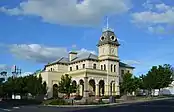 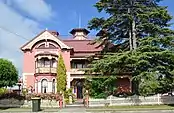 .jpg.webp) 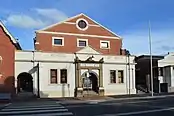 From left to right; Tenterfield Post Office, Historic Stannum House Bluff Rock near Tenterfield, the historic School of Arts | |||||||||
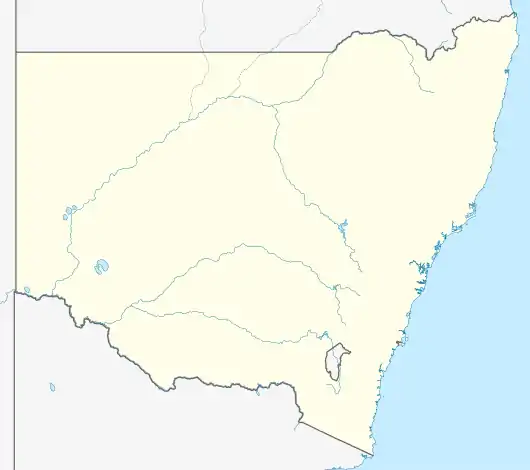 Tenterfield | |||||||||
| Coordinates | 29°02′55″S 152°01′04″E / 29.04861°S 152.01778°E | ||||||||
| Population | 4,066 (2016 census)[1] | ||||||||
| Established | 1851 | ||||||||
| Postcode(s) | 2372 | ||||||||
| Elevation | 850 m (2,789 ft) | ||||||||
| Location |
| ||||||||
| LGA(s) | Tenterfield Shire | ||||||||
| County | Clive | ||||||||
| State electorate(s) | Lismore | ||||||||
| Federal division(s) | New England | ||||||||
| |||||||||
Tenterfield is a regional town in New South Wales, Australia, situated at the junction of the New England and Bruxner highways, along the Northern Tablelands, within the New England region. At the 2016 census, Tenterfield had a population of 4,066.[1] Tenterfield's proximity to many regional centres and its position on the route between Sydney and Brisbane led to its development as a centre for the promotion of the federation of Australia.
Geography
Tenterfield is located at the northern end of the New England region, at the intersection of the New England and Bruxner Highways. The town is the seat of the Tenterfield Shire.[2] The closest nearby large town is Stanthorpe, Queensland, being 56 km north via the New England Highway. Tenterfield is three hours from Brisbane, Queensland (276 km), three hours from Byron Bay, New South Wales (205 km), two hours from Armidale, New South Wales (188 km) and eight hours from Sydney (663 km). The town is on the north-western stretch of the Northern Tablelands plateau, a spur of the Great Dividing Range, and is nestled in a valley beneath Mount Mackenzie (1,287m elevation), one of the highest points along the Northern Tablelands.
History
Tenterfield's first inhabitants were the Jukembal people who travelled the area from near Glen Innes to Stanthorpe, Queensland.

In 1841, Sir Stuart Donaldson was running 18,000 sheep on a property that he named Tenterfield Station, after a family home, Tenterfield House, in Haddington, Scotland.[3][4] Donaldson was the first premier of NSW and made biannual trips to Tenterfield to inspect his holdings there, which covered 100,000 acres (400 km2) of unfenced land. Tenterfield Post Office opened on 1 January 1849[5] and the township was gazetted in 1851 with allotments being sold in 1854. In 1858 gold was discovered at Drake (Fairfield) and shortly afterwards at Timbarra and Boonoo Boonoo.[6] During 1859 an AJS Bank opened and an Anglican church was built the following year. In the 1860s the Tenterfield Chronicle was published, the district court was established; the building of a hospital commenced and a public school was opened. In 1870 the population was less than 900, but the town had five hotels, a school of arts and three churches. The existing Tenterfield Post Office was constructed in 1881.
During World War II, Tenterfield was earmarked as a key battleground if the Japanese should invade Australia. During 1942 thousands of soldiers were set up in emergency camps, unbeknown to the locals, to cope with such an event. Overgrown tank traps and gun emplacements can still be seen on the Travelling Stock Route near the New England Highway.[7] The highway was until the early 1950s the only all-weather road from Sydney to Brisbane.
Heritage listings
Tenterfield has a number of heritage-listed sites, including:
- Railway Avenue: Tenterfield railway station[8]
- Manners Street: Tenterfield School of Arts[9]
- 225 Rouse Street: Tenterfield Post Office[10]
The following buildings and sites are listed on the now defunct Register of the National Estate:.[11] Also includes other buildings and sites as part of Tenterfield's history
- Stannum House, 114 Rouse Street, built c. 1888 by John Holmes Reid – exhibits ex-Buckingham Palace carpets and antique furniture
- Ayrdrie, Casino Road, country house built c. 1860[12]
- Tenterfield Post Office, built 1881[13]
- Court House, Gaol and Police Buildings, Molesworth Street, 1874–1882[14]
- Church of Our Lady of Perpetual Succour (Tenterfield Catholic Church), 73 Miles Street, oldest building in use in the Catholic Diocese of Armidale
- Tenterfield Saddlery, c. 1870, used as a private residence, bank and saddlery
- Tenterfield School of Arts, 203 Rouse Street, c. 1876
- Bald Rock National Park, 25 kilometres (16 mi) north of Tenterfield
- Boonoo Boonoo National Park, 23 kilometres (14 mi) north-east of Tenterfield
- Tooloom Falls Area, south-west of Urbenville
- Basket Swamp National Park, 19 kilometres (12 mi) north-east of Tenterfield
- Woolool Wooloolni/Wellington Rock Aboriginal Site, Basket Swamp National Park
- Aldershot Cottage, built c. 1860s
- Deloraine Cottage, built c. 1860s
- 124 High Street, built c. 1860s
- Flanagan's Men's Shop, oldest men's wear shop in Australia
Railway – Main North Railway Line
The railway opened to Tenterfield on 28 October 1884[15] and in 1886 to nearby Wallangarra/Jennings on the Queensland border, connecting Sydney and Brisbane, with a break-of-gauge at Wallangarra. When the rail link to the Queensland border was completed, Sydney and Brisbane were linked by rail for the first time. The railway was subsequently bypassed by the fully standard gauge North Coast line between Sydney and Brisbane, which was completed in 1932. The Main North line is now closed north of Armidale through to Wallangarra/Jennings, and the Tenterfield railway station is now a museum.
There was considerable debate about whether the break of gauge should take place at the existing town of Tenterfield, or at a whole new town at the border, which respectively became Wallangarra (Queensland side) and Jennings (New South Wales side).[16]
Tenterfield Oration
Sir Henry Parkes delivered his Federation Speech, commonly referred to as the "Tenterfield Oration", in the Tenterfield School of Arts on 24 October 1889.[15] He was travelling from Brisbane to Sydney, via the new Main North railway. The speech is credited with re-igniting the debate that ultimately led to Federation on 1 January 1901. Parkes never got to see his oration come to fruition, dying 5 years prior to the Federation of Australia.
Population
According to the 2016 census of Population, there were 4,066 people in Tenterfield.
- Aboriginal and Torres Strait Islander people made up 5.0% of the population.
- 80.6% of people were born in Australia and 86.7% of people spoke only English at home.
- The most common responses for religion were Anglican 24.7%, Catholic 24.3% and No Religion 19.1%.[1]
Industries
The main industries in the Tenterfield district are beef cattle breeding and superfine wool production through the breeding of Merino sheep. There are ten state forests in the Tenterfield district covering 7,540 hectares (18,600 acres).[17]
Media
The only commercial radio stations serving Tenterfield are Rebel Media stations, Rebel FM 93.7 and The Breeze 102.5.
The Tenterfield-based community radio station is Ten FM. The station also broadcasts to Stanthorpe north of the border, on a separate frequency.
ABC New England North West and ABC Radio National broadcast to Tenterfield on local FM repeaters.
Tenterfield's local newspaper is The Tenterfield Star, which is a weekly newspaper issued each Wednesday. The newspaper has been published for more than 170 years and was once owned by J. F. Thomas, the solicitor who defended Breaker Morant.
Tenterfield is incorporated into the Lismore television licence area and as such receives regional news bulletins on Seven and Nine along with brief local news updates on WIN Television's 10 Northern NSW (formerly Southern Cross 10).
Local geography
The local geography is dominated by prominent granite inselbergs and mountains, the most famous being that of Bald Rock, which sits within the Bald Rock National Park, and Bluff Rock which is located 12 minutes drive south of Tenterfield on the New England Highway. Prominent natural landmarks close to Tenterfield are:
- Mount Mackenzie – 1,258m elevation, south-west of CBD, and the highest point in the Tenterfield Shire. Used for television towers and Telstra towers. Features a 141-hectare nature reserve.
- Doctor's Nose – 1,165m elevation - features a 66-hectare nature reserve. Named for resembling the shape of the nose of a local doctor.
Climate
Tenterfield has a subtropical highland climate, with mild winters and warm wet summers with a high diurnal range due to its elevation. It sits at an altitude of 850 metres (2,790 ft) above sea level, meaning temperatures below freezing in winter are common. Tenterfield averages 47 mornings where the minimum temperature drops below 0 °C or 32 °F each year.[18] The town receives light to moderate snowfalls during severe winters. This only occurs once every 20–30 years, although the town experiences occasional sleet. The nearby Mount Mackenzie (1,287 metres or 4,222 feet elevation) generally receives light, sometimes moderate, snowfall annually. The town's last snowfall occurred during the winter of 2015, although, the most recent snowfall close to Tenterfield was on 4 June 2019, when a low pressure system swept north through NSW. This caused it to snow on Mount Mackenzie and other points above 1,000 metres or 3,280 feet throughout the New England region.[19] Summers are moderately warm to hot, with most days during the summer months reaching 23 °C (73.4 °F) or above, and not dropping below 15 °C (59 °F) overnight. The majority of precipitation occurs as thunderstorms, which can be severe. Tenterfield's highest recorded temperature was 39.9 °C (103.8 °F), which was recorded on 12 February 2017. Its coldest recorded temperature was −10.6 °C (12.9 °F), which was recorded on 10 July 2006.
| Climate data for Tenterfield (Federation Park) | |||||||||||||
|---|---|---|---|---|---|---|---|---|---|---|---|---|---|
| Month | Jan | Feb | Mar | Apr | May | Jun | Jul | Aug | Sep | Oct | Nov | Dec | Year |
| Record high °C (°F) | 38.3 (100.9) |
39.9 (103.8) |
35.6 (96.1) |
32.9 (91.2) |
27.1 (80.8) |
24.6 (76.3) |
23.3 (73.9) |
30.0 (86.0) |
31.2 (88.2) |
33.9 (93.0) |
36.2 (97.2) |
36.2 (97.2) |
39.9 (103.8) |
| Mean daily maximum °C (°F) | 27.1 (80.8) |
26.1 (79.0) |
24.6 (76.3) |
21.7 (71.1) |
18.0 (64.4) |
15.0 (59.0) |
14.4 (57.9) |
16.1 (61.0) |
19.5 (67.1) |
22.4 (72.3) |
24.9 (76.8) |
26.6 (79.9) |
21.4 (70.5) |
| Mean daily minimum °C (°F) | 14.4 (57.9) |
14.3 (57.7) |
12.4 (54.3) |
8.5 (47.3) |
4.9 (40.8) |
2.4 (36.3) |
1.0 (33.8) |
1.8 (35.2) |
4.7 (40.5) |
8.0 (46.4) |
10.8 (51.4) |
13.0 (55.4) |
8.0 (46.4) |
| Record low °C (°F) | 4.5 (40.1) |
4.0 (39.2) |
−3.0 (26.6) |
−5.0 (23.0) |
−8.8 (16.2) |
−9.3 (15.3) |
−10.6 (12.9) |
−9.5 (14.9) |
−7.2 (19.0) |
−3.4 (25.9) |
−2.0 (28.4) |
1.2 (34.2) |
−10.6 (12.9) |
| Average rainfall mm (inches) | 114.8 (4.52) |
93.4 (3.68) |
80.3 (3.16) |
47.3 (1.86) |
48.8 (1.92) |
50.5 (1.99) |
53.5 (2.11) |
43.9 (1.73) |
50.6 (1.99) |
76.3 (3.00) |
85.0 (3.35) |
105.3 (4.15) |
849.7 (33.46) |
| Average rainy days (≥ 0.2mm) | 10.5 | 9.9 | 9.7 | 7.1 | 7.4 | 7.6 | 7.3 | 6.5 | 6.4 | 8.1 | 8.7 | 9.9 | 99.1 |
| Source: Bureau of Meteorology,[18] | |||||||||||||
Mount Mackenzie Road Fire
On 6 September 2019, a grass fire started near Mount Mackenzie Road, opposite the Tenterfield Cemetery, to the south west of Tenterfield. The fire was exacerbated by dry winds and unseasonable heat due to a weather front that was sweeping across New South Wales. Within an hour, the fire was upgraded to an emergency level threat and swept across the southern edge of the town, jumping across the New England Highway. All schools in Tenterfield were evacuated[20] and power was cut to the town. The fire burned eastwards, within the vicinity of Billirimba road and Scrub road. 65 homes in the immediate area of the fire were saved.[21] one home was destroyed and 4 other homes damaged severely. 2 car yards, a pistol club and 12 outbuildings were destroyed and another 8 outbuildings damaged[21] A 66 year old Tenterfield local, Neville Smith, a volunteer NSW firefighter, was severely injured when the fire truck he was in was engulfed by flames while defending a property,[22] He was stabilised at Tenterfield Hospital then airlifted to Brisbane in a stable but critical condition.[22]
The fire continued to burn with an emergency warning throughout the night and was later downgraded by the New South Wales Rural Fire Service to a 'watch and act' level on 7 September as conditions on the fire grounds were easing due to cooler weather and large teams of firefighters with multiple aircraft assisting them with the fire.
Notable residents
.JPG.webp)
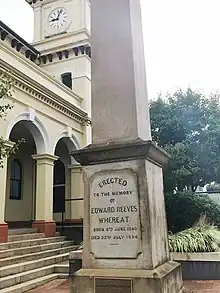
- Peter Allen, an entertainer who was born in and spent much of his childhood in Tenterfield, where he lived with his grandfather George Woolnough
- Bronwyn Bancroft, an indigenous Australian artist[23]
- William Blakely, born in Tenterfield in 1875, a botanist and plant collector
- Sir Harry Chauvel, born at nearby Tabulam, the first Australian to command a military Corps[17]
- William Folster, politician
- Robert Guy Howarth, born in Tenterfield in 1906, scholar, literary critic and poet
- Katherine Knight (born 1955), murderer who skinned her partner and cooked his body parts[24]
- Sir Clarence McKerihan, banker and president of the Rural Bank of New South Wales.
- Billy Moore, NRL footballer
- A.B. "Banjo" Paterson
- Jenny Saville, professional golfer
- Gary Shearston (1939–2013), singer and songwriter.
- Dr. Leonard Smith, Aboriginal Artist, Writer, Professional Rugby League Player, Australian Army Veteran and Philanthropist. Attended Tenterfield High in 1959
- Charlie Tapscott, two time paralympian silver medalist
- Major J.F. Thomas, a solicitor known for his vigorous defence of Harry "Breaker" Morant,[25] and once owned and operated the Tenterfield Star newspaper.[17][26] Jack Thompson portrayed Thomas in the 1980 film Breaker Morant
- Edward Reeves Whereat (1840–1894), an early community leader
- George Woolnough, Allen's grandfather, a saddler, the third person to own the saddlery and the subject of Allen's song "Tenterfield Saddler"
- Oliver Woodward, decorated First World War veteran and metallurgist
Sporting records
- The first campdraft ever held (to rules) was held in Tenterfield in c.1885.[17]
- The Australian showjumping record was broken at Tenterfield in 1926 Mrs A. A. Laidlaw's "Lookout", ridden by A. McPhee jumped 7’10¼".[6]
- The world showjumping record was broken at Tenterfield in 1936 by C. H. Perry's "Lookout", ridden by W Marton when he jumped 8’3½".[6]
- Guinness World Record achieved by then local Police Sergeant Troy Grant at the Tenterfield Golf Club in 2004 for the most holes of golf completed in 7 days.[27]
 Entrance sign to Tenterfield
Entrance sign to Tenterfield Tenterfield in 1861
Tenterfield in 1861 View of Tenterfield 1887
View of Tenterfield 1887 Main Street 1887
Main Street 1887.jpg.webp) Drovers, 1942
Drovers, 1942 Tenterfield Post Office
Tenterfield Post Office.JPG.webp) Post Office, Rouse Street
Post Office, Rouse Street Plaque with postcode
Plaque with postcode.JPG.webp) Railway Station, now a museum
Railway Station, now a museum.jpg.webp) Cherry pickers 1900
Cherry pickers 1900.jpg.webp) Scrub school 1923
Scrub school 1923 Tenterfield Rural Bank
Tenterfield Rural Bank.jpg.webp) Polling booth c.1925
Polling booth c.1925 Telegraph Hotel
Telegraph Hotel Weather predicting rock
Weather predicting rock.jpg.webp) Tenterfield Creek
Tenterfield Creek Blue Belle Café
Blue Belle Café.jpg.webp) Shops in Tenterfield
Shops in Tenterfield.jpg.webp) Autumn colours
Autumn colours Granite boulders on Kildare Road, Tenterfield
Granite boulders on Kildare Road, Tenterfield Spinning wool to knit socks for soldiers during World War I 1915
Spinning wool to knit socks for soldiers during World War I 1915 Boer War Memorial
Boer War Memorial Rail bridge
Rail bridge.jpg.webp) House in Tenterfield
House in Tenterfield Edward Parker's 1861 Cork Tree
Edward Parker's 1861 Cork Tree
See also
References
- 1 2 3 Australian Bureau of Statistics (27 June 2017). "Tenterfield (State Suburb)". 2016 Census QuickStats. Retrieved 3 January 2018.
- ↑ "Tenterfield Shire Council |". Archived from the original on 24 March 2019. Retrieved 24 April 2019.
- ↑ "Town blaze makes news Down Under". East Lothian Courier. Archived from the original on 6 March 2019. Retrieved 4 March 2019.
- ↑ "History". Tenterfield Station Homestead. Archived from the original on 6 March 2019. Retrieved 4 March 2019.
- ↑ Phoenix Auctions History. "Post Office List". Phoenix Auctions. Retrieved 21 January 2021.
- 1 2 3 Halliday, Ken, Call of the Highlands, Southern Cross Printery, Toowoomba, 1988.
- ↑ Reader's Digest Guide to Australian Places, Reader's Digest, Sydney.
- ↑ "Tenterfield Railway Station group". New South Wales State Heritage Register. Department of Planning & Environment. H01267. Retrieved 18 May 2018.
 Text is licensed by State of New South Wales (Department of Planning and Environment) under CC-BY 4.0 licence.
Text is licensed by State of New South Wales (Department of Planning and Environment) under CC-BY 4.0 licence. - ↑ "Tenterfield School of Arts". New South Wales State Heritage Register. Department of Planning & Environment. H01506. Retrieved 18 May 2018.
 Text is licensed by State of New South Wales (Department of Planning and Environment) under CC-BY 4.0 licence.
Text is licensed by State of New South Wales (Department of Planning and Environment) under CC-BY 4.0 licence. - ↑ "Tenterfield Post Office & Quarters". New South Wales State Heritage Register. Department of Planning & Environment. H01315. Retrieved 18 May 2018.
 Text is licensed by State of New South Wales (Department of Planning and Environment) under CC-BY 4.0 licence.
Text is licensed by State of New South Wales (Department of Planning and Environment) under CC-BY 4.0 licence. - ↑ The Heritage of Australia, Macmillan Company, 1981, pp.2, 246-247.
- ↑ "Ayrdrie House". NSW Govt Env & Heritage. Archived from the original on 15 July 2014. Retrieved 4 July 2014.
- ↑ "Tenterfield Post Office & Quarters". Archived from the original on 14 July 2014. Retrieved 4 July 2014.
- ↑ "Court House". Archived from the original on 24 September 2015. Retrieved 4 July 2014.
- 1 2 New England Regional Tourist Zone Association, New England Holiday, Express Print Armidale.
- ↑ "Untitled". The Morning Bulletin. Rockhampton, Qld. 17 March 1886. p. 5. Retrieved 15 November 2011 – via National Library of Australia.
- 1 2 3 4 Tenterfield & District, Tenterfield & District Visitors Assoc., n.d.
- 1 2 "TENTERFIELD (FEDERATION PARK)". Climate statistics for Australian locations. Bureau of Meteorology. March 2017. Retrieved 7 March 2017.
- ↑ "Visit Tenterfield on Facebook". Facebook. Archived from the original on 30 April 2022.
- ↑ Schools evacuated as bushfires approach homes in Tenterfield, 6 September 2019, retrieved 7 September 2019
- 1 2 "Initial assessment of fire affected areas". www.rfs.nsw.gov.au. Retrieved 7 September 2019.
- 1 2 "'Stoic' NSW firefighter engulfed in flames". www.themercury.com.au. 7 September 2019. Retrieved 7 September 2019.
- ↑ Kovacic, Leonarda (2004). "Bancroft, Bronwyn (1958 – )". The Australian Women's Register. National Foundation for Australian Women and University of Melbourne. Archived from the original on 8 June 2011. Retrieved 8 October 2009.
- ↑ Clarke, Phil; Briggs, Tom; Briggs, Kate (1 August 2011). Extreme Evil: Taking Crime to the Next Level. Canary Press eBooks. ISBN 9781907795916. Archived from the original on 11 November 2018. Retrieved 10 November 2018 – via Google Books.
- ↑ Unkles, James, Ready, Aim, Fire : Major James Francis Thomas, the Fourth Victim in the Execution of Lieutenant Harry "Breaker" Morant, Sid Harta Publishers, (Glen Waverley), 2018. ISBN 978-1-9252-3050-5
- ↑ "Brief Mention, The Richmond River Herald and Northern Districts Advertiser, (Friday, 23 Sep 1898), p.4". Richmond River Herald and Northern Districts Advertiser. 23 September 1898. Archived from the original on 18 December 2018. Retrieved 17 December 2018.
- ↑ Adams, Matt (10 February 2004). "Rusty putts his way to world record". Northern Daily Leader. Archived from the original on 16 January 2017. Retrieved 14 January 2017.
Further reading
- Donald, J. Kay (1987), Exploring the North Coast and New England, Kenthurst, NSW: Kangaroo Press, ISBN 0864171218
External links
- Local government site
- Tenterfield Business & Tourism Gateway
- Tenterfield Accommodation Directory
- Tenterfield Attractions
![]() Tenterfield travel guide from Wikivoyage
Tenterfield travel guide from Wikivoyage